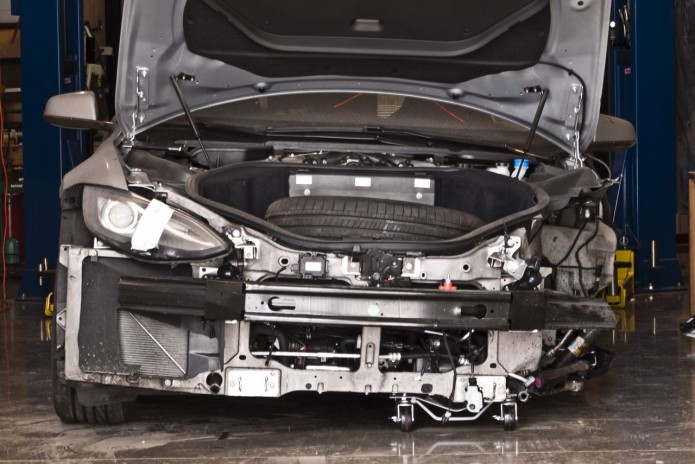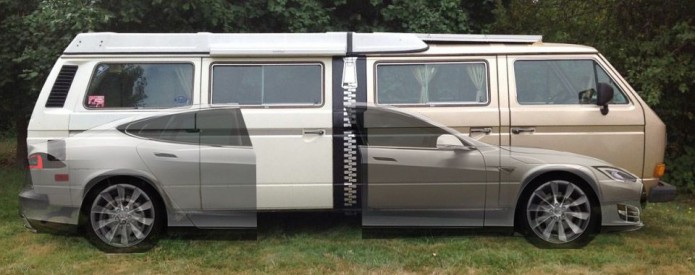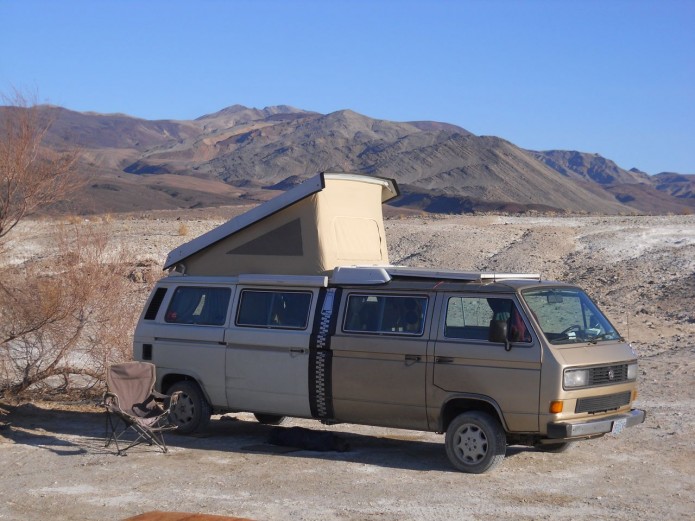Volkswagen Bus camping is in my blood.
From the day I came home from the hospital in the my family’s 1965 Transporter as a newborn, to what is now my second Stretch bus (a Vanagon Westfalia this time) I’ve travelled and camped in many VW busses. I can’t begin to count the number of times my family took the old green bus camping. I bought my first bus in high school. It was also a ’65 Splittie and waited less than a year before I grafted in the frame and drivetrain from a wrecked ’78 loaf. Modifications seem to be one of my favorite creative outlets.
EV’s
Electric vehicles came early as well. Living in Palo Alto I was lucky to have two engineers working on EV’s within a few blocks of my house. At the age of twelve I used their advice to convert my wooden go cart to electric propulsion. It was quite a sight. Surplus lawn mower wheels wobbled, old rope connected to a wooden steering wheel through a broomstick handle gave approximate direction control and the Delco generator wired as a shunt motor had adjustable field and electric reverse. Speed control was courtesy of the guts from a model train transformer. As with most of my EV’s it was a bit too fast to be safe, and it was fun! So naturally I would want to combine my love of VW camping with electric vehicles.
Electric Camping
Many discussions around the campfire were spent speculating on the possibilities of electric camping. Last spring I took my first electric camping trip in my electric 914 with a tent. But EV’s have this one problem, long recharge times have kept them incompatible with road trips. In the past you could drive maybe 100 miles in your EV and then find a place to charge for many hours, it meant a road trip would take extra days with long stops in less than ideal places. Then Tesla changed all that.
Superchargers change the game
In 2012 Tesla announced a true game changing technology; the Supercharger network. At 120 kW charge rate a long range EV can now get half a charge in 20 minutes, that’s on a 260 mile range 85 kWh car. I know I wouldn’t mind stopping for a 20 minute break every few hours on a road trip. This new network makes my long held dream of electric camping possible. Tesla Superchargers are wonderful and keep getting better. They are free to use if you own a Model S, fast and rapidly expanding across the country. They are owned by Tesla and the interface is proprietary. This means they only work on one car, the Tesla Model S. My problem is that the Model S is a bit small to be my favorite camping vehicle and I don’t see a bus in the Tesla roadmap.
The idea takes shape
It was last spring when the Stretchla project started to take shape. It all started when the young TDI engine in the Stretch threw a connecting rod through the block while returning home from California on I5, ironically it happened not long after I passed a car carrier full of new Teslas heading north for delivery. The thought of buying another internal combustion engine and spending a greasy week installing it was depressing to me. I parked the Stretch in the yard. Later I was camping in my electric 914 when my friend Jon suggested converting the Stretch to electric power. After all, he reasoned, most of the camping was within 100 miles and many campsites have power for charging. He was right, but that wasn’t going to get me from my home in Oregon to my favorite winter camping in Death Valley. At some point I noticed that Tesla was planning to put a Supercharger station just outside of Death Valley on Hwy 395. If I could only get the Stretch to plug into Superchargers I’d have it made. As far as I know Tesla has no interest in letting other EV’s use the Supercharger network. I don’t blame them and I didn’t even ask, building the network is a huge investment and a super sales tool for the Model S. If I wanted to use the Supercharger network, I figured I’d have to pay the cost of entry of buying a Tesla Model S. I’m sure you can all see where this is headed now. I love VW bus camping, EV’s and modifying cars. It’s simple really, I’ll buy a Tesla Model S and graft it onto the bottom of the Stretch. Sure the Vanagon brick-like aerodynamics will give less range and efficiency than the slick Model S, but I’ll get a powerful electric drive system with a huge battery, free Supercharging and an amazing dashboard to boot.
Moving forward
No, it won’t be easy. So far it looks like the most difficult modification I’ve attempted. Since it would be a waste to hack up a new Model S for this project I’ve been scouring the insurance auto auctions for a wreck that I can use for parts. I ended up with Vin# 07822. It has almost all the options I would have chosen. For those of you who speak Tesla those are: 2013, 85kWh, Active Air, Tech, Pano, 19″, Obeche, Black Leather and Jump Seats. The only additional option I would have liked is the dual chargers. Clearly it will need some replacement suspension parts in the front as well. As I write this it’s heading here on a truck from New York and I expect it to arrive in about a week.
The adventure begins!
If I knew what I was doing, I’d be bored. 
-Otmar

Copyright Otmar Ebenhoech

Copyright Otmar Ebenhoech

Copyright Otmar Ebenhoech

Copyright Otmar Ebenhoech

Copyright Otmar Ebenhoech

Copyright Otmar Ebenhoech

Copyright Joe Dovi, used with permission.
Like this:
Like Loading...














































